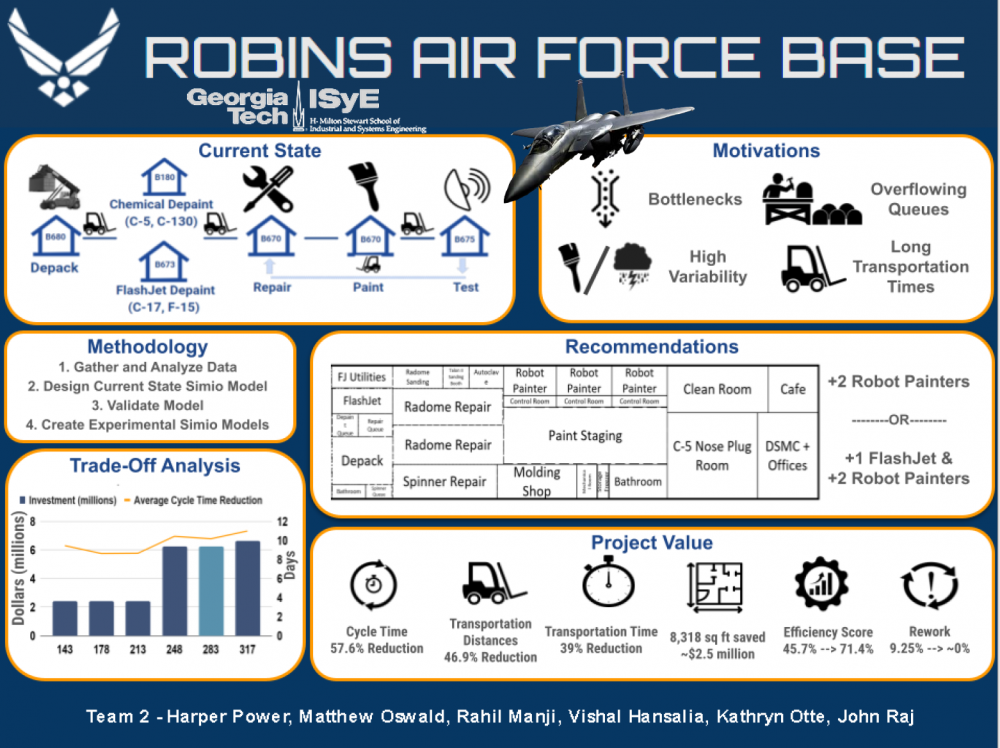Client Context
Robins Air Force Base is one of just three major repair and maintenance U.S. Air Force depots, and it is the only base that maintains the C-5, C-17, C-130, C-130 SOF, and F-15 aircraft. The system under consideration is the radome repair facility within the Warner Robins Air Logistics Complex (WR-ALC). Radomes are the nose of aircraft that house radar and other electronic equipment. The 402 Commodities Maintenance Group (CMXG) is responsible for repairs and maintenance while the 402 Electronics Maintenance Group (EMXG) acts as quality control by testing radomes after they are repaired by CMXG and deciding which radomes need rework. While all cargo aircraft radomes meet goal cycle times at the present demand level, the WR-ALC is unable to meet goal cycle times for F-15 radome repairs, which currently comprise the majority of the demand. Bottlenecks, inter-building travel steps, and variable processes lead to longer than desired cycle times. The WR-ALC intends to build a new facility specifically for radome repair and maintenance processes in 2030.
Project Objective
This project aims to increase radome repair capacity to keep pace with current and increasing demand by devising several potential process flows and facility layouts for the new facility. CMXG wants to consolidate the repair process into a co-located workspace and has requested facility layouts and investment recommendations to decrease cycle times (time in system). These new process flows and layouts should decrease transportation and weather delays, relieve bottlenecks, and add capability for managing demand variation. The facility layouts and trade-off analysis from this project provide a customizable solution for building a new radome repair and maintenance facility that will meet increasing demands on time and remain adaptable as Air Force requirements shift.
Design Strategy
The team used a simulation program called Simio to model the current state of the repair, maintenance, and testing process. The current system model allowed for diagnosis and greater understanding of the bottlenecks and other concerns within the repair process. First, the current state model was validated by comparing it to known average overall and individual station cycle times from CMXG. Then, the team used Simio to model future facility needs and test multiple design alternatives by changing variables in the current state simulation. These variables included demand level, demand composition, and number of workstations for each of the following process steps: FlashJet, painting, and EMXG testing. The next step involved comparing each configuration with average cycle times at or below the goal times in a trade-off analysis using the linear weighted sum optimization method for multi-criteria decision making. This analysis balanced metrics such as additional equipment costs, cycle time reduction benefits, and percent of radomes reworked.
The facility layouts, created in Visio, utilize outputs from the Simio model and trade-off analysis to determine the optimal number of workstations at each process step and the queue space necessary for each workstation. In addition, adjacency score metrics aided in creating a lean facility layout that minimizes travel distances. Each proposed facility layout represents a different level of investment and estimated cycle time reductions.
Deliverables
Trade-off Analysis - With possible changes to the Air Force’s budget and radome demand levels, the trade-off analysis allows the WR-ALC to compare the costs, cycle time benefits, and rework reductions for different investment levels. Each possible demand level has several investment options that vary in the amount of additional workstations recommended for the base to purchase. While the trade-off analysis scores each scenario according to the linear weighted sum optimization method, the weights used to score each metric are subjective based on current projections of each criterion’s importance. The WR-ALC can change these weights according to their preferences in order to choose alternatives that best suit their operations as factors change over time.
Facility Layouts - The team designed four facility layouts using the findings from the trade-off analysis. At the projected upper demand limit, the trade-off analysis recommends 2 additional robot painters. Depending on how much the WR-ALC is willing to invest to reduce F-15 cycle times, the trade-off analysis recommends potentially purchasing an additional FlashJet as well. The WR-ALC requested both square and rectangular layouts since the dimensions of the plot of land for the future facility are not known. The final deliverables incorporate the following facility layouts: a square layout with 1 FlashJet, a square layout with 2 FlashJets, a rectangular layout with 1 FlashJet, and a rectangular layout with 2 FlashJets. Each layout includes all other necessary repair and testing workstations as well as additional client requests, such as means of egress and fire safety considerations.


